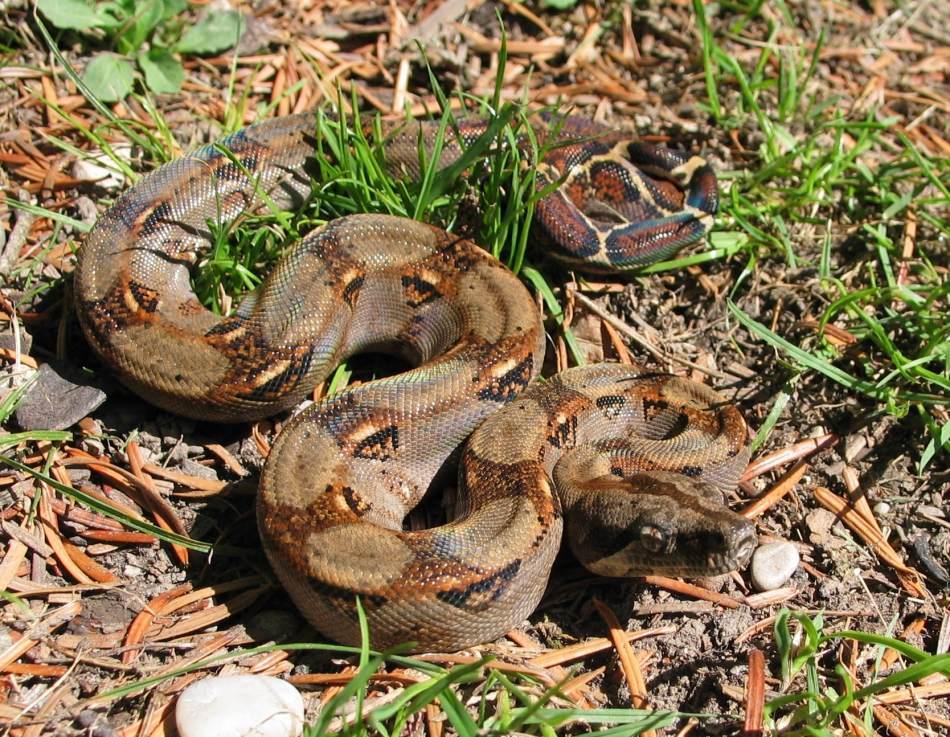

The cool end should be maintained at 75–85☏ (27–29☌), and the warm end at 86–92☏ (30–33☌).Temperatures should not be allowed to rise above 95☏ (35☌) or drop below 75☏ (24☌). A thermal gradient should be provided, with a cool end and a warm end where the heat source should be located. Glass, aquarium-syle enclosures are advised as they do not efficiently maintain temperature and humidity. Male boas should not be kept together as they may fight. The general rule is that the minimum length of the enclosure should be two thirds of the snake's length.Snakes are generally kept in separate enclosures, but people have successfully kept females together. However large females may need even larger enclosures. This enclosure is then increased as the boa grows, as large open spaces are stressful for young snakes. Young Boa constrictors should be started off in a relatively small enclosure, generally a terrarium. Proper animal husbandry is the most significant factor in captive lifespan, this includes providing adequate space, correct temperatures and humidity and suitable food items. Boa constrictors also have two lungs a smaller (non-functional) left and enlarged (functional) right lung to better fit their elongated shape, unlike many colubrid snakes which have completely lost the left lung.Captive life expectancy is 20 to 30 years, with rare accounts of over 40 years,making them a long-term commitment as a pet. Boa constrictors can sense heat via cells in their lips, though they lack the labial pits surrounding these receptors seen in many members of the boidae family. The others run from the snout to the eyes and then from the eyes to the jaw. One runs dorsally from the snout to the back of the head. GENERAL INFO: Boa constrictors have an arrow-shaped head that has very distinctive stripes on it. Climbing branches may be appreciated, especially with smaller boas.

A hot spot of almost 90F should be provided at one end. A small, heavy bowl of fresh water and shelter, such as a hollow log or concave rock or plastic “cave” are the three essential pieces of cage furniture.

HABITAT: Provide a substrate of aspen or wood mulch at least 2” deep. Frozen rodents are available in our food section. They are eating fuzzy mice and are about 10" -18" in length.ĭIET: Frozen thawed or live fuzzy mice.
BOA CONSTRICTOR IMPERATOR NAME SKIN
Hunted for their fine, ornate skin and for sale in the exotic pet trade, some boa constrictors have protected status in their range.SCIENTIFIC NAME: Boa constrictor imperatorĭESCRIPTION: We have imported Central American Boa Babies available now. The largest boa constrictor ever found measured 18 feet. Boas are about 2 feet long when they are born and grow continually throughout their 25 to 30-year lifespan. Reproduction and Conservationįemale boas incubate eggs inside their bodies and give birth up to 60 live babies. Their jaws can stretch wide to swallow large prey whole. Boas will eat almost anything they can catch, including birds, monkeys, and wild pigs. Their jaws are lined with small, hooked teeth for grabbing and holding prey while they wrap their muscular bodies around their victim, squeezing until it suffocates. Significantly smaller than anacondas, boas can grow up to 13 feet long and weigh more than 100 pounds. Like their anaconda cousins, they are excellent swimmers, but prefer to stay on dry land, living primarily in hollow logs and abandoned mammal burrows. Behaviorīoas are nonvenomous constrictors found in tropical Central and South America. Depending on the habitat they are trying to blend into, their bodies can be tan, green, red, or yellow, and display cryptic patterns of jagged lines, ovals, diamonds, and circles. Boa constrictors wear some of the most distinctive markings of all reptiles.


 0 kommentar(er)
0 kommentar(er)
